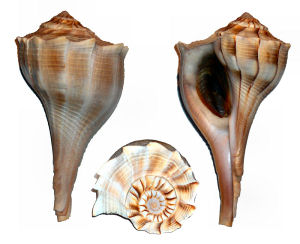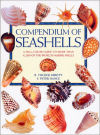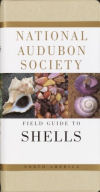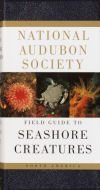
HOME
INTRO
SYMBOLS
ALMANAC
ECONOMY
GEOGRAPHY
STATE MAPS
PEOPLE
FORUM
NEWS
COOL SCHOOLS
STATE QUIZ
STATE LINKS
BOOK STORE
MARKETPLACE
NETSTATE.STORE
NETSTATE.MALL
GUESTBOOK
CONTACT US


Dbl click any word in
document for definition.
Texas State Shell

Texas State Shell: Lightning Whelk
The lightning whelk, Busycon perversum pulleyi became the state shell of the State of Texas when Governor Bill Clements signed House Concurrent Resolution No. 75 on April 14, 1987.
H.C.R. No. 75
HOUSE CONCURRENT RESOLUTION
WHEREAS, The State of Texas has traditionally recognized certain terrestrial forms indigenous to the state as official state symbols; and
WHEREAS, The bluebonnet, the pecan tree, the mockingbird, the topaz, and the palmwood are examples of some natural specimens that serve to symbolize the rich diversity of the plains, forests, skies, and mountains of our vast state; and
WHEREAS, In keeping with this custom, the designation of the Lightning Whelk as the State Shell of Texas will provide suitable recognition for the beautiful beaches and inlets of our Gulf Coast region; and
WHEREAS, Texas' coastlands, bays, and tidal flats provide a total of 634 miles of valuable natural resources and recreation areas, attracting thousands of visitors annually to this lush locality; and
WHEREAS, The Lightning Whelk, Busycon perversum pulleyi, is one of the most attractive and plentiful of the many shells lining our lovely beaches; and
WHEREAS, Found only along the West Coast of the Gulf of Mexico, the Lightning Whelk received its Latin name in honor of the late Dr. T. E. Pulley, a well-known Texas naturalist and teacher; and
WHEREAS, Of approximately 100,000 varieties of shells worldwide, the Lightning Whelk is the best known and one of the very few shells that normally opens on its left side; and
WHEREAS, The delicately sculptured specimen recently received national recognition when it was selected to appear on one of the first shell stamps ever printed by the United States Postal Service; and
WHEREAS, As enchanting as it is unique, the Lightning Whelk is the ideal choice for a state shell and will serve as a fitting emblem of the exceptional beauty of the Texas Gulf Coast region; now, therefore, be it
RESOLVED, That the 70th Legislature of the State of Texas hereby designate the Lightning Whelk, Busycon perversum pulleyi, as the State Shell of Texas.
At this time, Busycon perversum pulleyi is considered an invalid name. Busycon pulleyi is considered the appropriate name.
Picky, picky, picky...
Perhaps we're being too picky, but we think this designation is flawed. Here's why.
Busycon pulleyi is a large sea snail that lives along the west coast of the Gulf of Mexico. A sea snail carries a shell with it.
We know that the various species of sea snails can be differentiated by the shapes of their shells.
Texas has designated the lightning whelk their official state shell, but shouldn't they have more precisely designated the shell of the lettered olive their official state shell?
Most of the states that have designated official shells, like Texas, have not made the distinction but the most recent members of the official state shell club, New Jersey and Delaware, have passed legislation that carefully stipulates that it is the "shell of..." that they are recognizing, not the animal itself.
Texas Law
The lightning whelk was named the official shell of the State of Texas by House Concurrent Resolution and is not, therefore, listed in the Texas Statutes.
Only a few of Texas' myriad symbols were actually adopted by an act of the legislature and written into the Texas Statutes.
Sources...
Willy, John. The State of Texas. Texas State Legislature. House Concurrent Resolution No. 75. Austin: The State of Texas, 1987. Web.
Shearer, Benjamin F. and Barbara S. State Names, Seals, Flags and Symbols: A Historical Guide Third Edition, Revised and Expanded. Westport, Conn: Greenwood Press, 3 Sub edition, 2001.
Additional Information
Lightning Whelk, the State Shell Of Texas: Texas Parks and Wildlife Department.
Busycon perversum pulleyi Hollister, 1958: Integrated Taxonomic Information System (ITIS) Here you will find authoritative taxonomic information on plants, animals, fungi, and microbes of North America and the world.
State shells: Complete list of official state shells from NETSTATE.COM.
More symbols & emblems: Complete list of official Texas state symbols from NETSTATE.COM.

Smithsonian Handbooks
Shells
S. Peter Dance
Smithsonian Handbooks: Shells, by S. Peter Dance. 256 pages. Publisher: Dorling Kindersley (May 15, 2002) Authoritative text, crystal-clear photography, and a systematic approach make DK's Smithsonian Handbook of Shells the most comprehensive and concise pocket guide to seashells of the world. Packed with over 600 full-color photographs of over 500 species of seashells, this handy reference book is designed to cut through the complex process of identification.

Compendium
of Seashells
Compendium of Seashells, by R. Tucker Abbott and S. Peter Dance. 411 pages. Odyssey Publications; 4 edition (July 2000) A full-color guide to more than 4,200 of the world's marine shells. This comprehensive, full-color identification book on marine shells of the world is a must for serious shell-collectors and hobbyists. Combined by two of the world's leading malacologists, this beautiful and authoritative reference volume includes 4,200 full-color photographs to make shell identification quick and easy. All categories of marine shells are described and illustrated, including individual photographs, geographical and ecological information on hundreds of species of cowry, cone, valute, scallop, helmet and many others. Compendium of Seashells is designed to facilitate rapid location and identification of almost every shell likely to be found in a private collection or shell shop.

Field Guide to North
American Seashells
National Audubon Society Field Guide to North American Seashells, Revision authors are James D. Williams, Research Associate, Florida Museum of Natural History, and Carter R. Gilbert, Curator Emeritus of Fishes of the Florida Museum of Natural History. 896 pages. Publisher: Knopf (August 12, 1981) The essential book for beach-combers and divers, this guide explores more than 705 seashells, living mollusks, abalone, periwinkles, conchs, limpets, oysters, clams, mussels, and cockles found on the Atlantic, Pacific, and Gulf coasts of North America and the West Indies. The photographs are arranged by shape and color, making identification quick and easy.

Field Guide to North
American Seashore Creatures
Norman A. Meinkoth
National Audubon Society Field Guide to North American Seashore Creatures, by Norman A. Meinkoth. 816 pages. Publisher: Chanticleer Press ed edition (December 12, 1981) Each of the 690 identification pictures is a full-color photograph of a seashore creature. Arrangement by shape and by color makes identification quick and easy. 666 species are covered in full detail.

